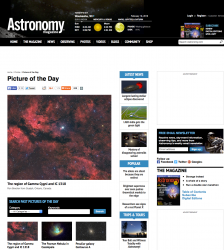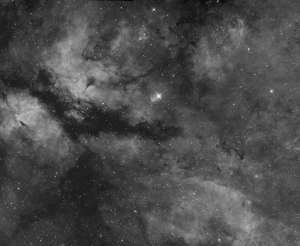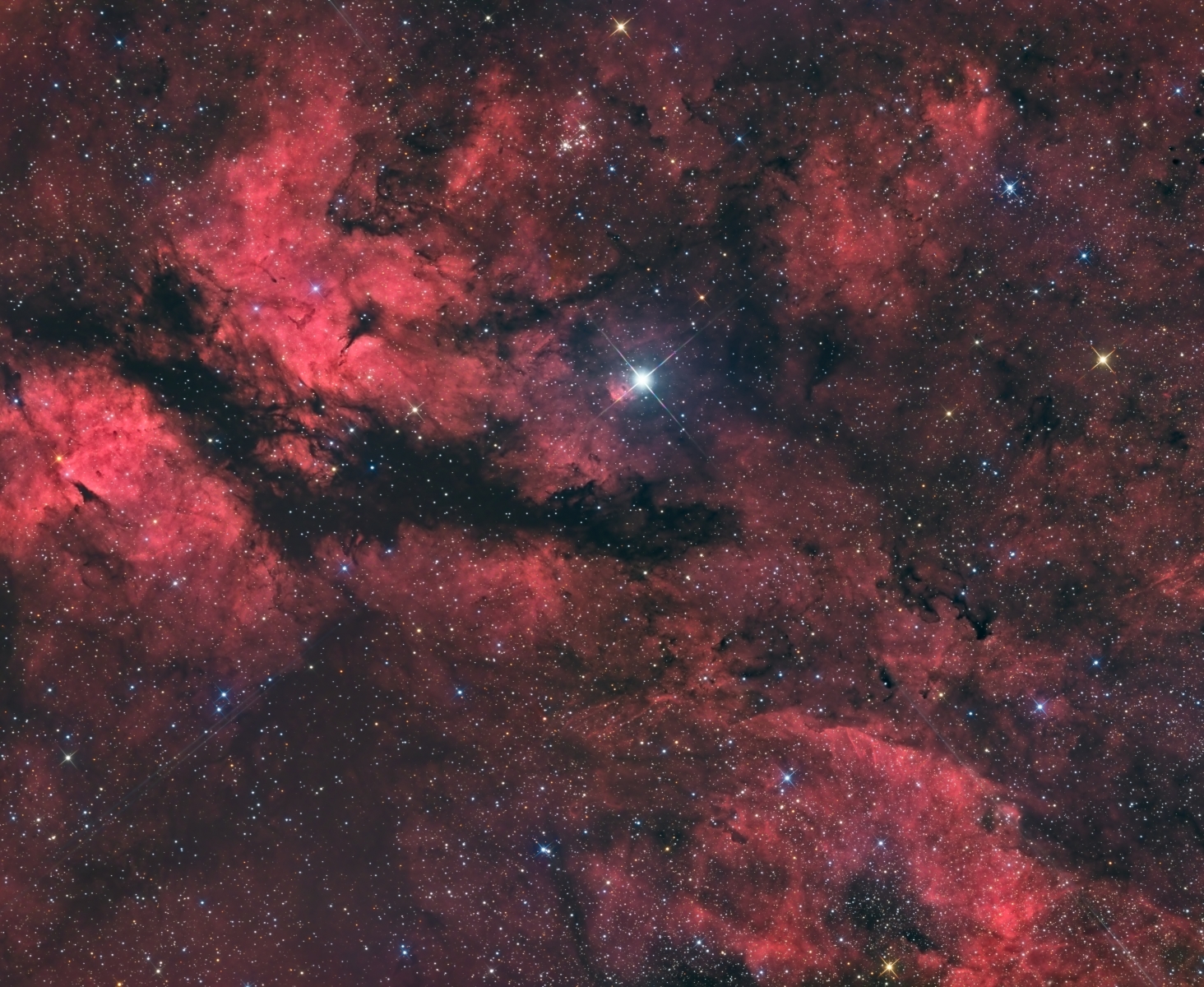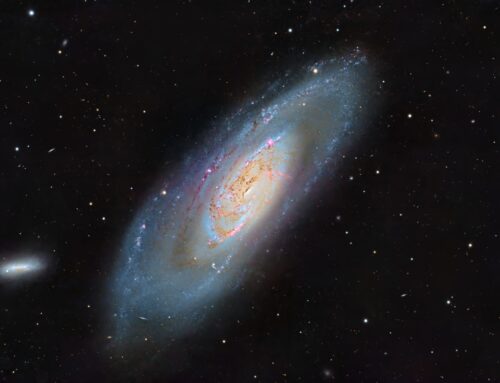IC1318, Gamma Cygni Region
Click here for full size image
January 10, 2015; Astronomy Magazine Picture of the Day Feb 19 2016
 IC1318 is the nebula around the bright star gamma Cygni, which is the star where the body and wings of Cygnus, the swan, cross in the sky. Cygnus is up very high in the sky in the summer and fall. Despite its appearance in this image, this nebula is actually faint and tenuous visually — the brightest parts are visible in a dark sky with a big telescope, but they look just like a faint haze in the eyepiece. The brightness of gamma-Cygni makes it challenging to see faint objects unless you keep the bright star out of the eyepiece field of view. This image shows a whopping 2.9 x 2.4 degrees, or about 28 times the area of the full moon. This huge image area was achieved by making a mosaic of two “panes.”
IC1318 is the nebula around the bright star gamma Cygni, which is the star where the body and wings of Cygnus, the swan, cross in the sky. Cygnus is up very high in the sky in the summer and fall. Despite its appearance in this image, this nebula is actually faint and tenuous visually — the brightest parts are visible in a dark sky with a big telescope, but they look just like a faint haze in the eyepiece. The brightness of gamma-Cygni makes it challenging to see faint objects unless you keep the bright star out of the eyepiece field of view. This image shows a whopping 2.9 x 2.4 degrees, or about 28 times the area of the full moon. This huge image area was achieved by making a mosaic of two “panes.”
 The colour image above blends the red, green and blue channels with data collected through a deep red H-alpha filter that lets in just the light emitted by hydrogen atoms. The black and white image at right shows the H-alpha data alone; click on the image to see it full size. The eye is better at picking out detail in black and white images than colour images. The stars are smaller in the Ha version because most starlight is emitted at wavelengths other than H-alpha. The colour and mono versions complement each other, and I hope you enjoy them both.
The colour image above blends the red, green and blue channels with data collected through a deep red H-alpha filter that lets in just the light emitted by hydrogen atoms. The black and white image at right shows the H-alpha data alone; click on the image to see it full size. The eye is better at picking out detail in black and white images than colour images. The stars are smaller in the Ha version because most starlight is emitted at wavelengths other than H-alpha. The colour and mono versions complement each other, and I hope you enjoy them both.
Tekkies:
SBIG STL-11000M camera, Baader LRGB filters, 10″ f/3.6 ASA astrograph, MI-250 mount. Guided with STL-11000’s internal guider. Acquistion, guiding, calibration, registration and integration all done using Maxim-DL. All processing in PixInsight. Focused with FocusMax. Shot from my SkyShed in Guelph, Ontario. Lots of moonlight for all shots (shot around full moon in Sept 2012). Above average transparency and average or below average seeing.
Mosaic of 2 panes acquired over 4 nights:
Pane 1: 11x20m Ha and 125m RGB acquired in 5m-subs
Pane 2: 9x20m Ha and 115m RGB acquired in 5m subs
Total integration time 10hr 40m
Mosaic Creation
Each pane’s data was used to make an RGB or Ha imagein Maxim DL (top and bottom RGB and Ha frames). These were cropped, processed in PixInsight with DynamicBackgroundExtraction, and StarAlignment was used to make top and bottom panes for RGB and Ha to use in GradientMergeMosaic, which was used to create an RGB and a Ha mosaic. ChannelExtraction was used to extract the R,G and B channels from the RGB image for use in making a synthetic luminance channel.
HaRGB
Creation and cleanup: The RGB image which processed with ColorCalibration. The NB-RGBCombine Script was applied with default settings to produce a linear HaRGB image. PixelMath was used to boost the blue by adding 3% Ha.
Stretching: HistogramTransformation was applied to make a pleasing yet bright image. TGV Noise was applied and the image was re-stretched to reset the black point.
Star Shaping: The sizes of the stars were reduced slightly with the MorphologicalTransformation tool to better match the small stars in the SynthL.
Synthetic Luminance and H-alpha only
Creation and cleanup: The cleaned up Ha, R,G and B masters were combined using the ImageIntegration tool (average, additive with scaling, noise evaluation, iterative K-sigma / biweight midvariance, no pixel rejection). The Ha master was copied, with the copy used for the Ha-only image.
The following steps were done in parallel on both the SynthL and Ha masters.
Deconvolution: A copy of the image was stretched to use as a deconvolution mask. A star mask was made from unstretched SynthL to use as a local deringing support. Deconvolution was applied (100 iterations, regularized Richardson-Lucy, external PSF made using DynamicPSF tool with about 20 stars; local deringing at 70% and global dark deringing at 0.02).
Linear Noise Reduction: MultiscaleLinearTransform was applied to reduce the noise. Layer settings for threshold and strength: Layer 1: 3.0, 0.5 Layer 2: 2.0, 0.35 Layer 3: 1.0, 0.2 Layer 4: 0.5, 0.1
Stretching: HistogramTransformation was applied to make a pleasing yet bright image. TGVDenoise was applied using a mask to protect stars and bright regions and the image was re-stretched to reset the black point.
Combining SynthL with HaRGB:
The luminance channel of the HaRGB image was extracted, processed and then added back into the HaRGB image as follows:
1. Extract luminance from the HaRGB image.
2. Apply LinearFit using SynthL as the reference.
3. Use ChannelCombination in Lab mode to replace the HaRGB’s luminance with the fitted luminance from step 2.
4. LRGBCombine was then used to make a SynthLHaRGB image.
Final Processing
HDRMT was applied at 6 and 4 pixel scales using a mask to protect stars. LHE was applied at scales of 50 and 150 using the same star mask (strength 0.5 for both). A range mask for the brightest highlights minus stars was made by subtracting a star mask from a range mask. The highlights were sharpened slightly with unsharp mask. Overall contrast, brightness and saturation 9were increased slightly with the Curves tool.
Image scale is about 2 arcsec per pixel for this camera / telescope combination.







Leave A Comment